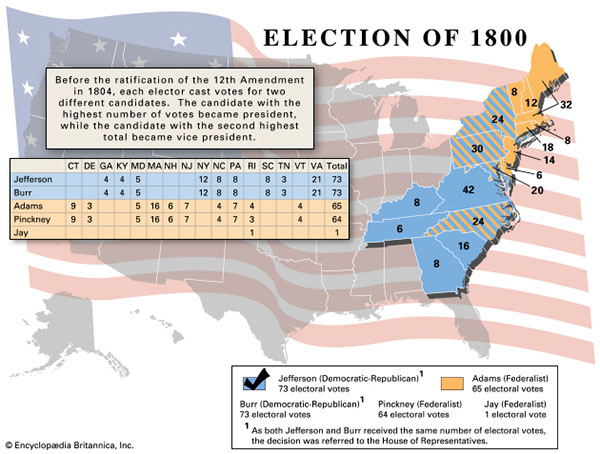The U.S. Presidential Election of 1800, in which Thomas Jefferson became president, spawned a political revolution that represented the true spirit of 1776.
The Federalists of the late 1780s and ’90s, who controlled the Presidency and Congress, stood in the way of popular democracy that the French Revolution had been the result of. This popular democratic spirit still resided in the United States during the late ’90’s under Federalist control.
The Federalists
The Federalists did believe in popular sovereignty and a republican form of government, but didn’t believe that common people should have a direct role in representative government. They believed their form of government was better than the Democratic-Republican one. They thought American society would become less concerned with democratic principles of equal rights of all citizens and more concerned with preserving the traditional system of social classes, much like British society from which America moved away from in 1776. The Federalists treated the common people with condescension and wouldn’t reach out to them politically. Their view of the U.S. Presidency was one that reflected a certain kind of elected monarch. This view was quite different from the popular view of the presidency and government that the Democratic-Republicans believed in. As a result, they wanted a second revolution that threatened to tear the Union apart.
The Democratic-Republicans
The Democratic-Republicans, or simply called “Republicans”, were a political faction started by Thomas Jefferson while serving as Secretary of State under Federalist George Washington. He believed in popular government based on the new French republic. He was against monarchies or a strong executive, high taxes, oppressive debts and standing armies. He believed in republican forms of government that had less government control. He was against the monopolies of banks and the money-obsessive capitalists that were already present in the North. Furthermore, he was a true believer in liberty and democracy, so much that he ran for president against Federalist Vice-President John Adams in 1797, losing to him but serving as Adams’ Vice-President. Back then, the losing candidate for president automatically became Vice-President.
Jefferson personified the revolutionary radical with his ideas of liberty and democracy. But despite his ideas, he was a well-connected, highly cultivated, wealthy Southern landowner in which he used hundreds of slaves to maintain his land and home, according to Gordon S. Wood in his 2009 book Empire of Liberty, A History of the Early Republic, 1789-1815. The slave-holding aristocrat became the biggest spokesman for liberty and democracy at that time.
The Election of 1800
Jefferson ran for president again in 1800 as a Democratic-Republican, along with John Adams for a second term as a Federalist. Aaron Burr, a wealthy New York lawyer, also ran as a Democratic-Republican. The Constitution then didn’t say that the presidential electors, that elected candidates to the office, had to distinguish between their votes for president and vice-president separately. Jefferson and Burr had received the same number of votes. Therefore, according to the Constitution, the election had to be decided by the House of Representatives, where each state would have a single vote. The newly elected “Republican” majority in Congress would not be seated until December 1801. Despite being a Republican, the Federalist wanted to elect Burr president, in opposition to Jefferson. Chief Justice John Marshall, a Federalist appointee, wanted to. He had doubts about Jefferson’s character and ideas for the nation. He did not have the same reservations about Burr. In the House of Representatives, nine states were needed for election. Although the Federalists had a majority of congressmen, they controlled only six state delegations. The Republicans controlled eight. The congressional delegations of two states, Vermont and Maryland, were evenly divided between the two parties. There was a concern that there would be no one elected president by Inauguration Day (March 4, 1801). Federalists talked of Congress selecting a temporary president and Republicans talked of holding a new election. Federalists wanted to manipulate the process through legal and constitutional means, while Republicans wanted to have faith in the general population by having the choice for president decided by the majority party; a party that had the most votes by the general public in Congress. Alexander Hamilton, a Federalist, preferred Jefferson, even though he and Jefferson were bitter rivals in terms of ideology. But Hamilton thought Jefferson had character unlike Burr.
Throughout February, 1801, the House voted 35 times with no majority. As Inauguration Day drew closer, Republican newspapers talked of military intervention. The governors of Virginia and Pennsylvania were preparing their militias for action. Mobs gathered at the capital in Philadelphia and threatened to prevent any man from being appointed as president by statute. On February 15, Jefferson wrote Virginia Governor James Monroe that the Republicans had warned the Federalists that any statutory appointment of a president would lead to the arming of the Middle States. He also wrote that Republicans threatened to call a new constitutional convention. According to Jefferson, this would give the Federalists “horrors; as in the present democratical spirit of America, they fear they should lose some of the favourite morsels of the constitution.”
The Final Result
Finally on February 17, some Federalists in Congress abstained from voting, and on the thirty-sixth ballot, Jefferson was elected president, winning ten states. Burr won four states.
In order for a smoother election process, avoiding another controversy like the one in 1800, Congress adopted the Twelfth Amendment to the Constitution, which allowed electors to make their choices for president and vice-president on separate ballots. It turned the Electoral College from a decision-making body to one that was to apportion votes and demonstrated that presidential politics had become popular in a way that the Founding Fathers had not foreseen.
References:
- Wood, Gordon S. Empire of Liberty, A History of the Early Republic, 1789-1815. 2009. Pages 276-280, 283-285.








